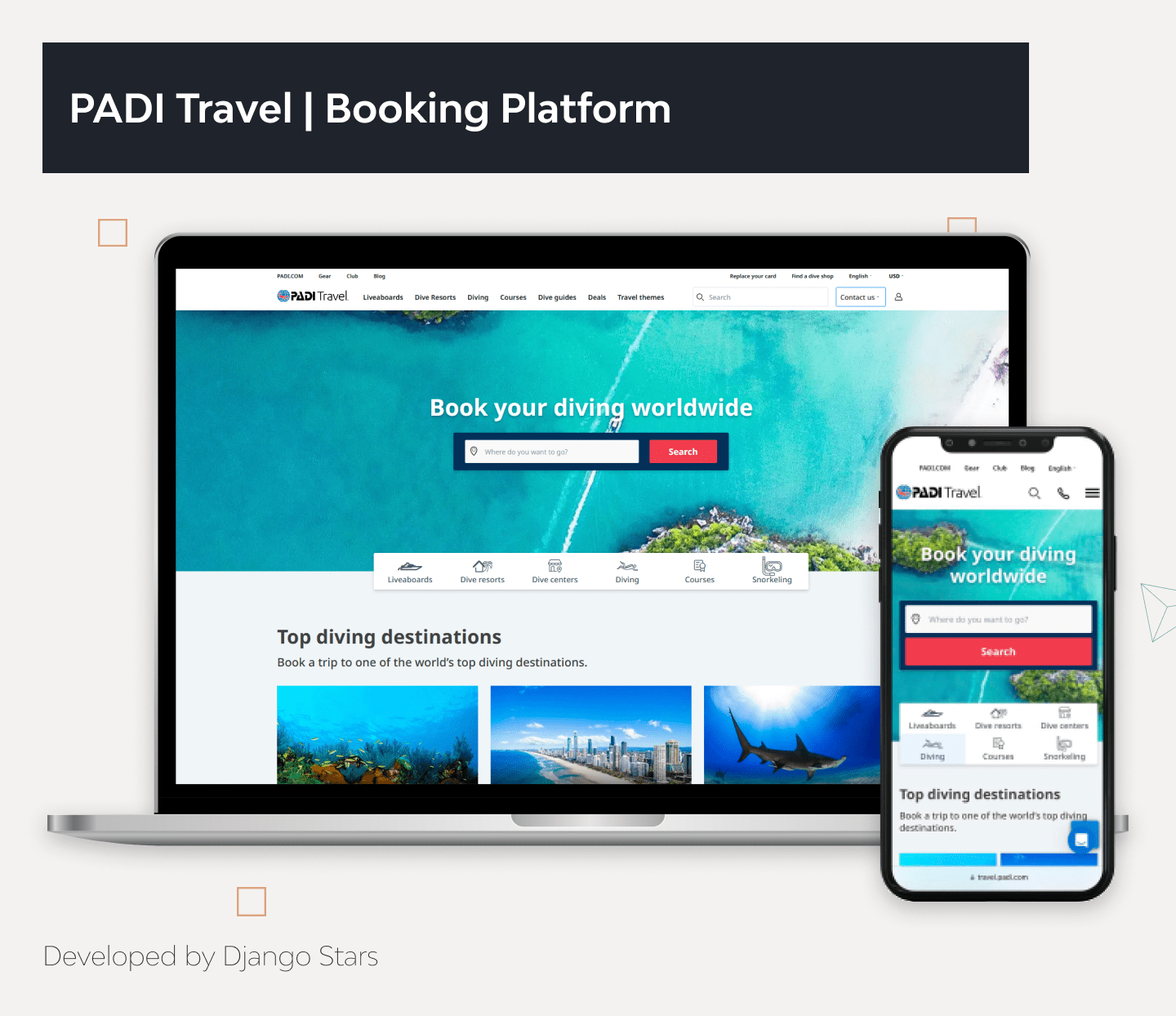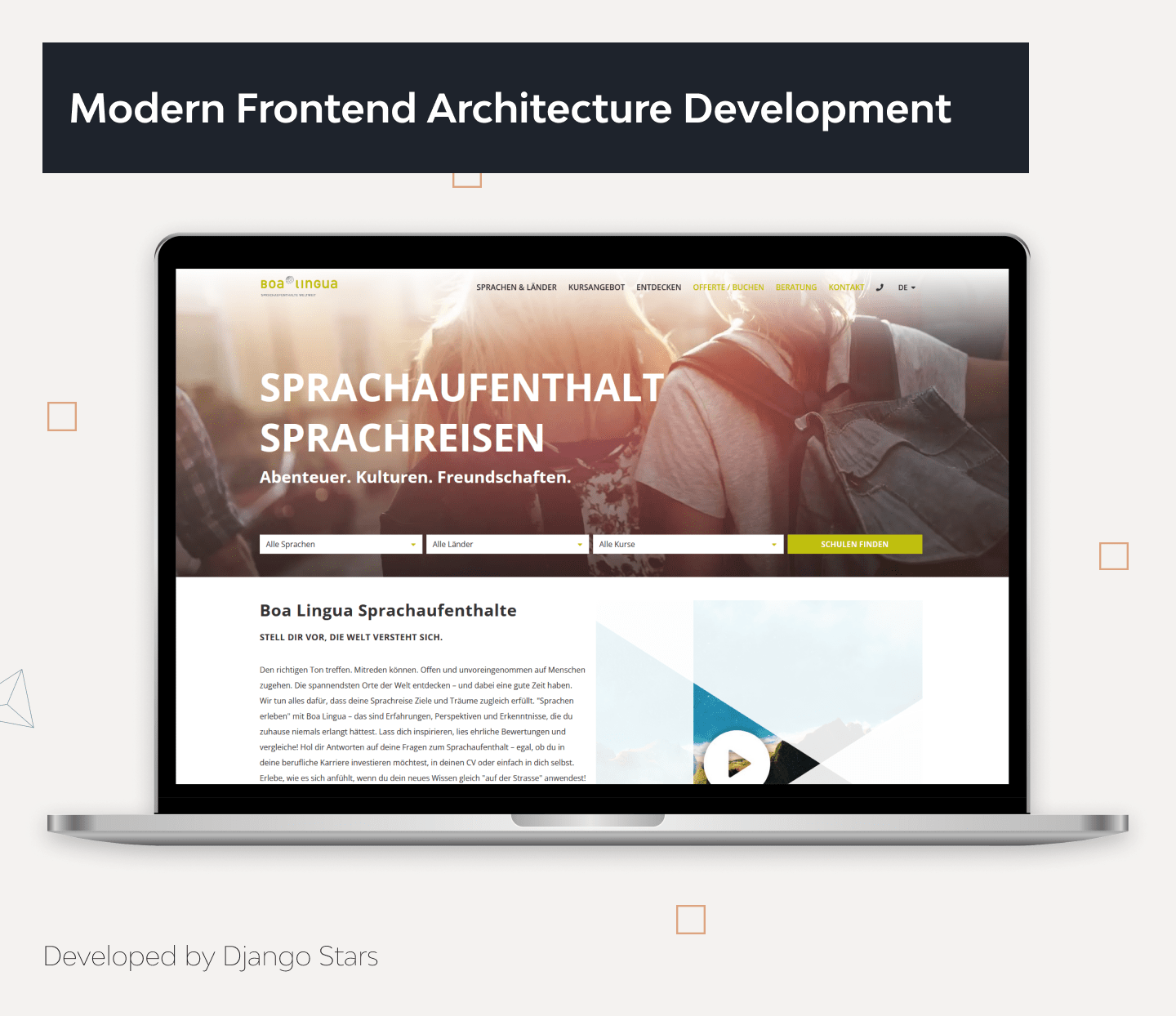Building the Frontend for Booking Platforms: Scalable & Resilient

Hospitality businesses need to prioritize scalability when building the frontend for booking platforms. The platform represents the brand, so if it performs poorly, the company may lose customers with little chance of winning them back.
However, by following scalable frontend principles and rules, companies can achieve outstanding user experience and performance. Scalability also means thinking several steps (or years) ahead. It’s about maintaining the platform’s performance as the business and demand grow.
This article provides tips on building a truly scalable frontend architecture for a booking platform. We wrote it to share the practices that helped our client save money, deploy the product faster, and improve its overall quality. Finally, we wanted to warn you about the hidden development complexities that can lead to expensive rework.
First, however, we would like to present some projects we have carried out for travel and hospitality companies and explain the specifics of their development.
Booking Platforms with a Scalable Frontend: Django Stars’ Cases
At Django Stars, we have developed several booking engines with robust search functionality, filtering and reservation features. Making such complex platforms convenient and high-performing is usually the most challenging part. But although it’s hard, it’s never impossible if you pay attention to scalability during development.
We have created a travel platform that helps scuba divers find and book the best destinations. The Django Stars team has made sure that the shopping mechanism makes it possible to find and book the exact room the customer wants. The platform also integrates with the company’s B2B platform, allowing other businesses to list their services. More importantly, the frontend we created has excellent personalization capabilities and can handle a high volume of traffic.

Django Stars has also modernized a legacy booking system for language courses. Originally, the company used phones and offices to communicate with clients. We automated most processes by adding advanced search, filtering, and booking features to the website. We also had to revamp the frontend and backend to handle the influx of customers, hotel administrators, and support staff.

In addition, our portfolio shows various projects we have completed across industries (including booking, travel, and transportation). This wealth of experience results in the scalable frontends we develop for our clients using the following tips and practices.
Tip 1: Prioritize SSR for the Frontend Application Architecture
Booking platforms contain many reusable web page elements and descriptive pages. We use Server-Side Rendering (SSR) for these static components.
SSR lets the server generate and send the initial HTML markup to the user. This technique means the user’s browser initially loads and renders most of the data. In contrast, Client-Side Rendering (CSR) lets the user’s browser render the page only after downloading JavaScript elements that will load any required data from API, which impacts first loading application speed.
A proper development framework is critical for SSR. Most companies choose between Gatsby and Next.js because the pages built using them can load without extra processing on the server.
Gatsby is optimized for static site generation (SSG), which means that all pages are generated in advance and quickly delivered to the user’s browser during the request. Any change to the project will result in re-generating all pages or some of them when using incremental builds. This works if a company has strict specifications for the project and does not plan to update the structure of the booking app often.
Next.js is much more flexible in comparison. It is a hybrid framework for SSG, SSR, incremental generation, and CSR. Thus, it’s better to choose Next.js to make the project adaptable to any changes regarding page structure and rendering during development.

And there is another point. The fact that SSR allows search engines fully index the website’s content should improve search engine optimization (SEO). But search engines consider a variety of other factors, including performance. In this regard, SSG has an advantage that can potentially improve ranking due to page load speeds. Finding the best SEO strategy requires experimentation. And if the company is considering changing its frontend architecture concepts (e.g., moving from CSR to static pages and SSR), it’s all the more reason to prefer Next.js. Its flexibility reduces the potential cost of reworks and functionality enhancements.
Tip 2: Determine the Method of Content Page Creation
Which is better: using a Content Management System (CMS) or a page builder? Or is a custom admin solution more appropriate? This largely depends on the specific requirements of the project. It’s a crucial decision, and clients should have a comprehensive roadmap to aid developers in selecting the system that meets all requirements and is straightforward to implement.
Builders enable faster page creation through drag-and-drop capabilities, pre-built templates, and real-time page preview, while CMSs are designed to populate a booking platform with content. These tools typically have a visual interface that allows non-technical users to update, modify, and publish web pages.
When selecting a fitting builder and CMS to build a scalable frontend, companies should consider both technical and business requirements. Some important considerations include the following:
- Roadmap. An approved roadmap with all the necessary functions for a long time will help choose the CMS as accurately as possible.
- Complexity. Avoid using complicated tools for superficial reasons. For example, a Python-based CMS (like Wagtail) offers no tangible benefits for applications built on Python – it just leads to more rework. WordPress is a better choice for most booking platforms, thanks to its extensive library of plugins and themes.
- Interoperability. Both tools should work together for seamless content management. They should also exchange data with other systems, such as enterprise resource planning (ERP) and customer support services.
- Content strategy. Booking platforms often change their content management strategy. The CMS and web builder should be flexible enough for possible changes as the business grows or changes its focus.
Some companies create pages manually because they need more control over the design. In this case, it’s still important to investigate the features, capabilities, and suitability of a CMS for specific use cases. Developers should compare different options and test them for content publishing.
Tip 3: Optimize Typography and Animations for a Better UX
A carefully designed user experience (UX) ensures that users can find the room or other reservation information, and typography and interactive elements play an important role in achieving this.
Consistent typography elements
Typographic elements don’t look the same everywhere. Font size may appear disproportionate on different devices, making text difficult to read. Also, the content and line height may look cluttered if the user splits the screen.
Moreover, sophisticated fonts may be unsupported on some operating systems. In this case, the browser can automatically replace the font with a common font, ruining the experience the designers had intended, or download it before the page loads.

It’s important to make sure the typography is consistent across devices using the following practices:
- Use web-safe fonts. Check which CSS fonts are pre-installed on most operating systems. For example, some versions of Windows don’t have Helvetica, and Calibri isn’t available on macOS. However, almost all devices support Arial.
- Integrate Google Fonts. Google offers a collection of widely supported open-source fonts, as well as variable fonts that developers can customize based on contextual rules.
- Use adaptive CSS. If you use CMS make sure that content changes won’t break the general page view.
Consistent typography is one of the essential scalable frontend rules. It can prevent the booking platform from looking off-brand, which affects the customer’s decision to convert. It can also increase the page load time, as the browser doesn’t download the missing font file before opening the site.
Visual components and interactivity
Visuals can help people stay on the platform long enough to book reservations. Here are some of the ways to enhance visual components:
- Smooth out loading times. Simple loading animations, such as spinning circles and loading dialogs, trick users into thinking the page is loading faster.
- Add transitions for page redirects and for interactive content changes inside the page. Add a skeleton screen instead of a white space to reveal the context of the rendering page.
- Add interactivity to make the experience more engaging. A site that shows immediate visual feedback from mouse movements and other interactions has a more engaging effect on users.
- Optimize media for mobile devices. Setting the container width for images ensures that they don’t appear oversized on the user’s screen. Make sure to add attributes for different devices and resolutions.
- Consider color contrast. Different color combinations can make components on the page stand out. For example, a “Book Now” button may have a darker background or more contrasting text.
- Optimize animated elements. Animations draw a user’s attention to important information.
Tip 4: Properly Plan and Develop the Product Pricing Logic within the Project
The pricing logic for a project can become quite intricate, depending on the application requirements, potentially demanding significant server resources for calculation. For instance:
- Some services may alter the prices of other services added to the cart.
- Alternatively, the total price of the order may fluctuate based on the quantity of services added.
- Each service might have its unique reservation requirements and specific dates when reservations can be made.
If the platform hosts a multitude of users, and many are simultaneously adding services to their carts, these calculations could heavily burden the server. In some cases, it may be beneficial to distribute such logic across microservices or pre-cache the calculations in others. If the logic isn’t complex, there’s no need to optimize it, and it can be kept dynamic.
Implementation depends on the complexity of the project, but it’s important to understand the intricacy of such calculations in advance and make the necessary decisions for its optimization.
Tip 5: Consider the Future App Localization from the Outset
Even if the application is currently focused on serving the local market of its home country, it doesn’t mean that it can’t potentially expand to the global market in the future. In such a scenario, the need to incorporate multiple languages into the project may arise. Moreover, some countries may have several official languages at the national level, and it’s essential to consider this.
It’s incredibly important to incorporate the logic for future content translations during the development phase. This will take considerably less time than adding localization to a finished product and will save a tremendous amount of time for the developers, as well as significant costs for the clients. Therefore, the app creators should address these issues during the project planning stage.
Tip 6: Consider Utilizing the Cloud and CDNs
Cloud computing is preferable for travel and booking services with customers from relatively remote locations. A cloud resource geographically closer to the user increases the application loading speed.
Simply put, loading a page from a company’s server in Chicago will take longer for a user in the Philippines. A website in a cloud, on the other hand, means the user’s browser doesn’t have to travel as far to retrieve the data, which reduces the page’s loading speed.
Companies can also invest in Content Delivery Networks (CDNs). These can store, cache, and distribute static assets (like generated HTML pages, images, animations, and videos) to users in close proximity, further improving load times.
Combining scalable front-end architecture patterns can result in a booking platform that’s both intuitive and fast-performing.
Front-End Features That Make a Booking Platform Successful
To meet user expectations and gain popularity, a booking platform’s frontend should offer a simple and intuitive interface that can enhance the user experience and make the booking process easier, even for not tech-savvy users. This implies using clear and concise language and straightforward navigation.
In addition, a booking platform would ideally incorporate the following features:
- Responsiveness. The booking platform should be optimized for different devices, including desktop computers, tablets, and smartphones. Using responsive design principles helps to ensure the services’ accessibility on all screen sizes.
- Customizable search filters. The platform should have robust search functionality, allowing users to search for properties, dates, and other relevant criteria. This should include the ability to filter search results based on specific requirements.
- Prices displaying/comparison. Users can search for the most attractive offers and make informed decisions about booking if the platform has a feature to compare prices across different channels and display them in one place.
- A calendar. Accessing the calendar from the booking platform interface provides a convenient way for users to select dates and check availability. Additionally, the calendar can showcase special events, promotions, or seasonal offerings, allowing users to easily identify and take advantage of favorable opportunities.
- Real-time availability. Showing the current availability of the services being booked can provide users with more accurate information and increase their trust in the platform.
- Maps. Location display is also essential for most booking services. Therefore, the platform’s frontend will benefit from integrating a mapping service, such as Google Maps.
- Personalization. Users want the ability to customize their search and booking experience based on their preferences. This could include saving favorite properties, setting up notifications for new listings, and customizing their search results.
- Multiple payment options. A variety of available payment options can make the booking process more convenient and increase the chances of conversion.
- Booking confirmation and reminders. Sending confirmation emails, notifications, and reminders can improve user satisfaction and reduce the likelihood of no-shows.
- Reviews and ratings. Displaying honest feedback from other users can help build trust and credibility with potential customers.
Various third-party integrations (for example, with mapping services, social media, and review aggregators) that improve the booking platform’s overall functionality and UX can increase its visibility and reach.
Money-Cutting Strategies for Modern Frontend Architecture Development
We use many practices to trim the development costs and technical overhead in our web projects. Here are the ones that apply to all kinds of travel booking applications:
- Prioritize static pages. Static pages load faster than dynamic pages. They’re pre-built, which makes caching much easier to implement. In addition, fewer dynamic pages put less load on servers, resulting in savings on computational costs.
- Use SEO. It is essential for booking platforms, so make sure your HTML and main front-end architecture is SEO friendly.
- Compress media on the website. Most images and videos can be compressed or converted to mobile-friendly formats without sacrificing quality. This can reduce hosting and bandwidth costs and improve page load speed.
- Make reusable components for development. Making universal reusable components reduces costs in the long run. It saves time on designing and coding similar frontend features for each page. An example would be a universal button component that allows functionality to be customized to current needs for the booking platform like changing button color, size, etc.
- Standardize design components. Designers need to collaborate with developers at all stages of booking platform development. Ideally, they should agree on all design specifications for components, such as layout, styling, and functionality. Doing so can accelerate the creative processes and ensure the consistency of web page elements.

Using these strategies, especially reusable components, can have a dramatic impact on productivity. In one of our projects, such components helped the client reduce the time needed to create a page from a day to a few hours.
Avoiding common slip-ups and mistakes is another good way to reduce unnecessary expenses.
Mistakes to Avoid When Building the Frontend for a Booking Platform
Even experienced developers can make mistakes that affect the frontend. This section looks at the most common oversights and how to avoid them during development.
1. Neglecting Mobile-First Design
With the increasing prevalence of mobile device usage, failing to prioritize mobile-first design could result in a subpar user experience for a significant portion of the audience. The booking platform’s frontend should be designed with responsiveness in mind, ensuring that it operates smoothly and efficiently on various screen sizes and devices.
2. Ignoring Performance Optimization
Users value speed and efficiency. Neglecting performance optimization can lead to slow page loading times and inefficient functionality, causing user frustration and potential loss of business. Consider implementing practices like code minification, lazy loading, and proper image optimization.
3. Failing to Plan for Scalability
The frontend should be designed with scalability in mind. As the booking platform grows and evolves, it needs to be prepared for an increase in user traffic, more extensive data handling, and new features. Overlooking this aspect can result in a cumbersome and inefficient system that fails to meet growing demands.
4. Overlooking Accessibility
Accessibility is crucial in ensuring that the booking platform is usable by as many people as possible, including those with disabilities. Failing to adhere to web accessibility standards could exclude potential users and possibly lead to legal issues. Therefore, it’s vital to incorporate features such as screen-reader compatibility, sufficient color contrast, and keyboard navigability.
5. Neglecting Communication with the Design Department
Effective collaboration between developers and the design team is crucial for successful frontend development. If developers fail to maintain regular communication with designers, it can lead to inconsistencies, misinterpretations, and reworks, which can waste valuable time and resources. Ensuring that the project includes regular check-ins and discussions between these teams helps guarantee a shared vision and seamless integration of design into the platform.
6. Not Standardizing Reusable Components
One of the key aspects of efficient frontend development is creating and implementing a library of reusable components. Not doing so can lead to inconsistencies across the platform, repeated code, and a more complicated maintenance process. A component-based approach encourages code reuse and consistency throughout the platform, leading to a more coherent user interface and easier code maintenance.
7. Ignoring Low-Resource Machines
When developing a booking platform, it’s important to take into account users who might be accessing the site from low-resource machines. Overlooking this aspect might result in an inaccessible or unenjoyable user experience for these users. To ensure optimal performance for all users, the platform should be optimized for resource efficiency, including aspects like memory usage, CPU utilization, and network bandwidth. This involves code optimizing, reducing the number and size of assets, and considering efficient server-side rendering techniques.
8. Not testing the booking platform on user devices
Developers and quality assurance specialists usually test web applications on their corporate computers, which are designed to process large amounts of data. But they often forget that performance and appearance can be very different on everyday devices.
It’s therefore important to check the user interface, frontend functionality, and usability on newer and older operating systems. This includes older versions of Windows and Mac, tablets, phones, and different browsers.
Conclusion
Adhering to scalable frontend rules helps ensure consistency in UX, performance, and reliability. The practices and technologies described can help create a feature-rich booking platform that can handle large traffic spikes. In addition, they allow companies to integrate new features and experiment with SEO without excessive rework or skyrocketing costs.
Django Stars has extensive knowledge to build efficient booking services from scratch, guide companies through digital transformation, and help them scale. We’re always happy to discuss the full range of our development services and business offerings.
- What is a scalable frontend architecture?
- Scalable frontend refers to a client-side (user-facing) part of the web application that can adapt to growing functionality and traffic. A scalable frontend for a booking platform means maintaining usability, reliability, and performance as the application gains more users and develops more complex features.
- What are the principles of a scalable frontend?
- Optimization, maintainability, consistency, and modularity are the key scalable frontend principles. Modularity allows breaking the web application into reusable and independent components. Consistency means keeping a consistent user experience across the platform. Maintainability can be achieved by writing clear code that is easy to test, update, and debug. Optimization is about improving page load speed without compromising functionality.
- Does the Django Stars team provide frontend development services for booking platforms?
- Yes. Django can develop, modernize, and maintain custom online booking systems for travel, transportation, and hospitality businesses. We cover the entire product life cycle — from ideation to post-release scaling. Plus, our portfolio includes BC2, B2B, and B2E solutions for various industries.










